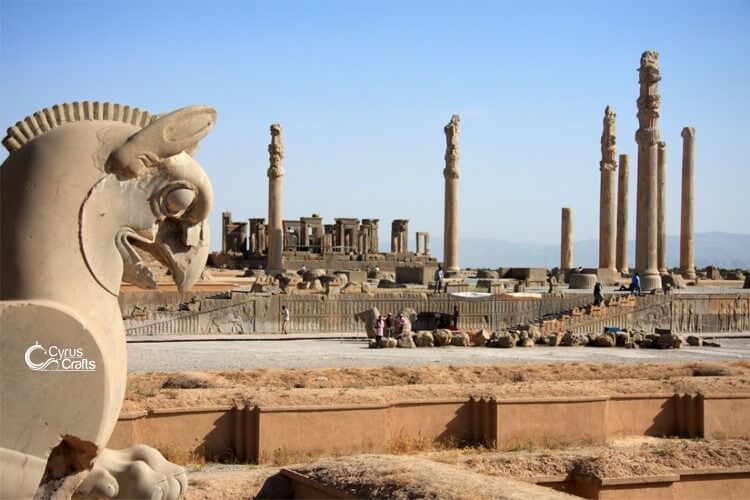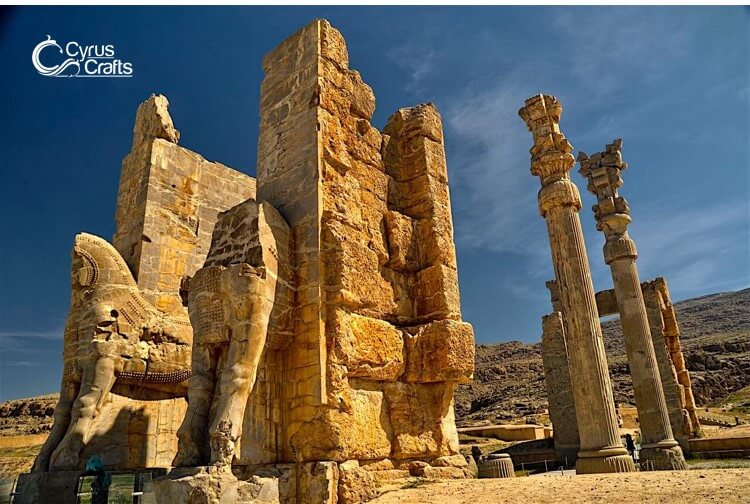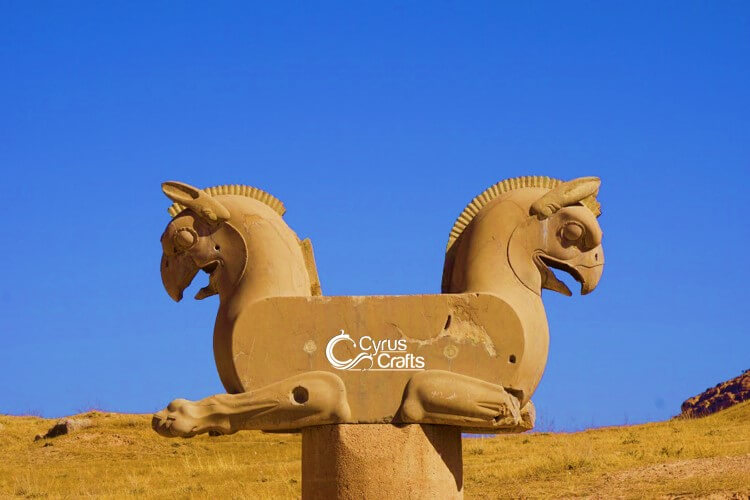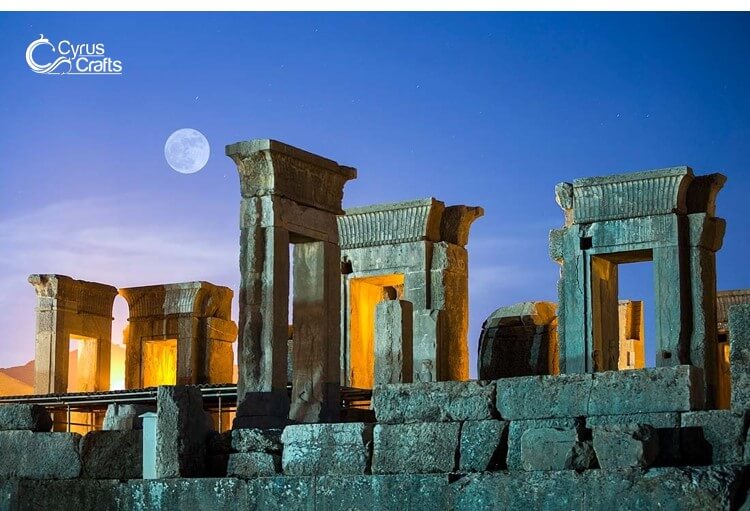- News
- 2278 views
- 0 comments
- historical
Persepolis is known as a symbol of Persian civilization in Iran. This area, which is one of the sights of Fars province and is located near Marvdasht, Shiraz, shows the architectural glory of the palace of kings in the era of ancient Iran. At the height of their power, the Achaemenid kings built their stone palaces in the heart of the mountain near the city of Shiraz to leave a clear picture of the future of their rule for the future.
Columns, column heads, inscriptions, reliefs, palaces, and gates left, and also the tomb of Cyrus The Great in this area are among the world's most famous works of civilization. The location area attracts many tourists worldwide to Shiraz throughout the year.
The construction of the throne of Jamshid was started by Darius the Achaemenid about 25 centuries ago and at the foot of the mountains of mercy.
Countless architects and artists participated in the construction of the Persepolis building, and these immense buildings were built by male and female workers. And it can also be said that it is one of the best-lasting buildings in the history of Persian architecture. According to the information in the inscriptions, the construction of this world heritage took about 120 years. The prominent culture of the rulers of the ancient Persian empire during the Achaemenid period has caused the fame of ancient civilizations of ancient Iran in the world.
Where is Persepolis?
Persepolis is located in a pleasant climate area near Merv Dasht, Shiraz, in Fars province, Iran. (See on the map)
Despite the tropical nature of many parts of Fars province, this region near Marvdasht has a cool and temperate climate due to its mountainous environment.
What is the history of Persepolis?
Here we have to tell you that to know the history of Persepolis, imagine an older place than the Rome Amphitheater in Italy, the Copan of the Mayan city in Honduras, or the Killef Palace in Colorado.
The construction of this area dates back to 518 BC, about 2500 years ago. Darius I, the third Achaemenid king, ordered the construction of a huge palace in the mountains around Marvdasht. But the structure of the mansions and statues of the zone took a long time. It continued during the reign of later kings.
The construction and completion of the throne of Jamshid palaces continued until the end of the Achaemenid rule. Still, many parts of this building were built and decorated during the time of Darius I, Xerxes, and Ardashir I. The magnificent palaces of this world heritage were the residence of the Achaemenid kings for many years and are still considered one of the most prominent and enduring historical documents of ancient Iran.
Cyrus Crafts; Luxury & Unique Products
The selection of the mountains around Marvdasht by Darius I, considering the hill's location about sunrise and sunset, green plains around it, and this area's location on the royal road, has been brilliant.
In recent years, due to the extensive damage to the buildings of Persepolis, this area has been repaired many times. In 1930, the reconstruction of Takht-e Jamshid was under the supervision of the American Archaeological Group. During the excavation, the inscription of Xerxes was discovered. Thus they were able to identify the palace of Queen Xerxes. A few years later, in 1935, a German group reconstructed some of the inscriptions and strengthened the palaces and columns of Apadana Palace.
The reconstruction process continued until 2000, which led to the discovery of many works and inscriptions from this area. Many of these works are in the Persepolis Museum. Some works discovered are kept in the National Museum of Iran; many pieces have also been taken out of the country and placed in museums and libraries in Europe and the United States.
How old is Persepolis?
Persepolis' buildings are more than 2500 years old. Historical relics of the Elamites and early governments in ancient Iran have been discovered in parts of Iran. Still, due to its greatness and glory, this glory of history can be considered the most prominent historical monument from ancient times in Iran.
Persepolis is world-famous, and in many world-famous museums, samples of works discovered on the throne of Jamshid are kept. Although this area is located in Iran, in terms of outstanding historical potential and having signs of the oldest historical civilizations, it is a great treasure for all world's people. This historical site has been one of Iran's UNESCO World Heritage Sites since 1979.
Persepolis inscription text
There are more than 3,000 reliefs in different parts of Persepolis palaces, in which common concepts can be found. The number of these designs is not comparable to other reliefs left by the Achaemenids in other parts of Persia. It can be concluded that masonry began in this world heritage during the Achaemenid period.
The discovery of the Takht-e Jamshid bas-reliefs was first started by the American Archaeological Team, led by Professor Herzfeld, around the 1930s and continues to this day. The inscriptions discovered in Persepolis are also fascinating. Most of which have been read by the same American team and the results have been published.
The text of the inscriptions of Darius the Great (the third Achaemenid king)
Darius the Great, king of kings, king of the lands, son of Vishtasp the Achaemenid, who is the builder of this palace. Ahuramazda, which is the country of Persia, has good horses; they give me good men. At the request of Ahuramazda and I, Dariush Shah, I am not afraid of anyone else. Ahuramazda will help me. He does. From the enemy, from drought, and lies. Come to this country, not an enemy, not a deficit, not a lie; let me ask this as a gift from Ahuramazda to the royal family. May Ahuramazda give me this goodness with the royal family. I am Darius the Great, the king of kings, the king of many, the son of Vishtasp the Achaemenid.
The text of the inscription of Ardashir I
Great is Ahuramazda, who created the heavens, this earth, created the people, created happiness for the people and made Ardashir king. At the request and approval of Ahuramazda, I completed the palace that my father Xerxes had begun to build. May Ahuramazda immortalize me and my prince and what I did.
The best time to travel to Persepolis
Visiting Persepolis in the hot seasons of the year can be annoying due to the open area of this legacy of the heritage and direct sunlight. The best time to travel to the throne of Jamshid is in the second half of the year. It is better to choose the early hours of the day or visit the Achaemenid empire in the afternoon and after the weather cools down.
In the cold seasons of the year, after sunset, the area of the Takht-e Jamshid and its surroundings are cold, So bring the right clothes with you. Cloudy days are also very suitable for visiting this area; Because there is no direct sunlight. It is better to have a hat and sunglasses with you for convenience.
Nowruz is the best time to travel to Shiraz and Persepolis. When you can smell the pleasant scent of orange blossoms in the air. This season, many tribes from all over Iran and the world travel to Shiraz to see Persepolis.
Are you planning to travel to Persepolis, the city of culture and civilization? Write to us. In what season would you like to travel to beautiful Shiraz to see Persepolis? If you have any questions about handicrafts in Fars province, visit the Cyrus Craft page.








Comments (0)